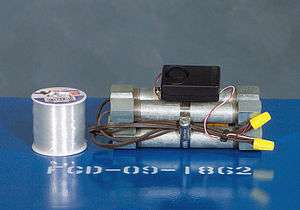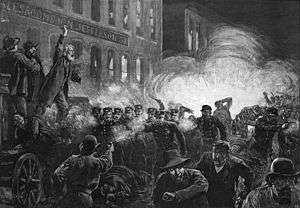Pipe bomb

A pipe bomb is an improvised explosive device, which uses a tightly sealed section of pipe filled with an explosive material. The containment provided by the pipe means that simple low explosives can be used to produce a relatively large explosion, and the fragmentation of the pipe itself creates potentially lethal shrapnel.
Premature detonation is a hazard of attempting to construct any homemade bomb, and the materials and methods used with pipe bombs make unintentional detonation incidents common, usually resulting in serious injury or death to the assembler.
In many countries, the manufacture or possession of a pipe bomb is a serious crime, regardless of its intended use.
Design

The bomb is usually a short section of steel water pipe containing the explosive mixture and closed at both ends with steel or brass caps. A fuse is inserted into the pipe with a lead running out through a hole in the side or capped end of the pipe. The fuse can be electric, with wires leading to a timer and battery, or can be a common fuse. All of the components are easily obtainable.
Generally, high explosives such as TNT are not used, because these and the detonators that they require are difficult to obtain. Such explosives also do not require the containment of a pipe bomb.
Instead, any sort of explosive mixture the builder can find or make is used, and some of the explosive mixtures used, such as gunpowder, match heads, or chlorate mixtures are very prone to ignition by the friction and static electricity generated when packing the material inside the tube or attaching the end caps—accounting for many injuries or deaths amongst builders.[1] If sharp objects, such as nails or broken glass, are added inside the bomb in an attempt to increase the amount of injury, these also add to the risk of premature ignition.
Operation
Pipe bombs concentrate pressure and release it suddenly, through failure of the outer casing. Plastic materials can be used, but metals typically have a higher bursting strength and so will produce more concussive force. For example, common schedule 40 1-inch (25 mm) wrought steel pipe has a typical working pressure of 1,010 psi (7.0 MPa), and bursting pressure of 8,090 psi (55.8 MPa),[2] though the pipe sealing method can significantly reduce the burst pressure.
The pipe can rupture in different ways, depending on the rate of pressure rise and the ductility of the casing material.
- If the pressure rise is slow, the metal can deform until the walls become thin and a hole is formed, causing a loud report from the gas release, but no shrapnel.
- A rapid rate of pressure rise will cause the metal to act as a crystal and shatter into fragments, which are pushed outward in all directions by the expanding gases.
Modes of failure
Pipe bombs can fail to explode if the gas pressure buildup is too slow, resulting in bleed-out through the detonator ignition hole. Insufficiently tight threading can also bleed gas pressure through the threads faster than the chemical reaction pressure can rise.
They can also fail if the pipe is fully sealed and the chemical reaction triggered, but the total pressure buildup from the chemicals is insufficient to exceed the casing strength; such a bomb is a dud, but still potentially dangerous if handled, since an external shock could trigger rupture of the statically pressurized casing.
Minimum evacuation distances
If any type of bomb is suspected, typical recommendations are to keep all people at a minimum evacuation distance until authorized bomb disposal personnel arrive. For a pipe bomb, the US Department of Homeland Security recommends a minimum of 21 m (69 ft), and preferred distance of 366 m (1,201 ft).[3]
Uses
Pipe bombs are by nature improvised weapons, and typically used by those without access to military devices such as grenades. They were successfully used in the Spanish Civil War (1936–1939). During World War II, members of the British Home Guard were trained to make and use them.[4]
In Northern Ireland, there have been hundreds of pipe bomb attacks since the mid 1990s (towards the end of the "Troubles"). Most of the attacks have been launched by loyalist paramilitaries opposed to the 1994 ceasefires, especially the Red Hand Defenders (RHD) and Orange Volunteers (OV). However, they have also been used by Irish republican paramilitaries and by anti-drugs vigilante group Republican Action Against Drugs (RAAD). They are also used extensively in the south of Ireland by feuding criminals and drug dealers alike, mainly in the capital city of Dublin.
As well as users such as criminals, paramilitaries, and militias, they also have a long tradition of recreational use for amusement or mischief with no intention to cause injury to anyone, but due to the dangers of premature ignition and of shrapnel, pipe bombs are much more dangerous than alternatives, such as dry ice bombs.
Notable incidents

- On 4 May 1886, a pipe bomb was thrown during a rally at Haymarket Square in Chicago, Illinois, United States.[6] It reached a police line and exploded, killing policeman Mathias J. Degan.[6] The bomb was made from gas-pipe filled with dynamite and capped at both ends with wooden blocks.[6]
- On 27 July 1996, Eric Rudolph used a pipe bomb in the Centennial Olympic Park bombing during the 1996 Summer Olympics in Atlanta, Georgia, United States. It killed two people and injured 111.[7]
- On 25 July 1997, during the July 1997 riots in Northern Ireland, a well-known loyalist was found dead in Belfast. He is thought to have died in a premature pipe bomb explosion at an arms dump.[8]
- On 5 June 1999, a Protestant civilian was killed when a pipe bomb was thrown through the window of her house in Portadown, Northern Ireland. She was married to a Catholic man. Loyalist Volunteer Force (LVF) members were blamed, although the group denied responsibility.[9]
- On 20 April 1999, Eric Harris and Dylan Klebold used pipe bombs during the Columbine High School massacre.[10]
- On 11 November 2001, an Ulster Defence Association (UDA) member died in a premature pipe bomb explosion during a riot in Belfast, Northern Ireland.[11][12]
- On 3 January 2002, another UDA member died in a premature pipe bomb explosion in Coleraine, Northern Ireland.[13][14]
- On 10 August 2006, four pipe bombs were found in and around the city of Salem, Oregon, United States. Some suspected a "serial pipe bomber" was at fault. A man was later arrested and charged.[15][16]
- On 11 December 2010, a suicide bomber detonated one out of six pipe bombs close to a major shopping district in Stockholm, Sweden, killing himself with no other casualties. The incident is known as the 2010 Stockholm bombings.[17]
- In January 2011, a potentially deadly pipe bomb was discovered along the route of a Martin Luther King Jr. memorial march in Spokane, Washington. The bomb, which was shaped, was defused and there were no casualties.
- On April 19, 2013, the Boston Marathon bombing suspects, Dzhokhar and Tamerlan Tsarnaev, are alleged to have thrown pipe bombs out of an SUV they had carjacked in a shootout with Boston police.[18]
- On September 20, 2013, 18-year-old Skylar Murphy was caught with a pipe bomb at Edmonton International Airport. The Canadian Air Transport Security Authority staff confiscated the device, but permitted him to board his international flight, and only informed the Royal Canadian Mounted Police four days later. Murphy was arrested when he returned to Canada on September 27, and later sentenced to one year's probation and fined $100.[19]
References
- ↑ Dias, Gary A.; Dingeman, Robbie (2004). Honolulu CSI: An Introduction to Forensic Science and Criminal Investigation. Bess Press. p. 87. ISBN 978-1-57306-228-2.
- ↑ The bursting pressure below is based on Barlow's formula. The working pressure is based on factor 8. Dimensions are based on ASME/ANSI B36.10/19. http://www.engineeringtoolbox.com/wrought-steel-pipe-bursting-pressure-d_1123.html
- ↑ Bomb Threat Stand-Off Distances, nctc.gov
- ↑ Introduction by Campbell McCutcheon (30 September 2012). Home Guard Manual 1941. Amberley Publishing Limited. p. 77. ISBN 978-1-4456-1103-7.
- ↑ "Act II: Let Your Tragedy Be Enacted Here, Moment of Truth". The Dramas of Haymarket. Chicago Historical Society. 2000. Retrieved 2008-01-19.
The details are factually incorrect, because by all accounts Fielden ended his speech before the bomb was thrown, and because the riot did not begin until after the explosion. In [this] depiction, the speech, the explosion, and the riot all take place at once.
- 1 2 3 Lawson, John Davison; Robert Lorenzo Howard (1919). American State Trials: A Collection of the Important and Interesting Criminal Trials which Have Taken Place in the United States from the Beginning of Our Government to the Present Day. Thomas Law Books. p. 64.
- ↑ "Rudolph reveals motives". CNN.com. 19 Apr 2005.
- ↑ "CAIN: Issue: Violence - Chronology of 'pipe-bomb' attacks". Cain.ulst.ac.uk. Retrieved 2012-01-14.
- ↑ A Chronology of the Conflict: 1999 - Conflict Archive on the Internet
- ↑ "Columbine Massacre". About.com. 24 Aug 2006.
- ↑ "CAIN: Sutton Index of Deaths". Cain.ulst.ac.uk. Retrieved 2012-01-14.
- ↑ "Police hunt loyalists after bomb death". BBC News. 12 November 2001. Retrieved 22 May 2010.
- ↑ http://findarticles.com/p/articles/mi_qn4158/is_20020105/ai_n9670628. Missing or empty
|title=(help) - ↑ "CAIN: Issues: Violence - Draft List of Deaths Related to the Conflict in 2002". Cain.ulst.ac.uk. Retrieved 2012-01-14.
- ↑ "Pipe Bombs Found in The Salem Area". Salem-News.com. 13 Aug 2006.
- ↑ "Salem Pipe Bomb Suspect Back in Court Tuesday". Salem-News.com. 13 Feb 2007.
- ↑ Sweden: Stockholm suicide bombings could have been 'catastrophic', London: The Telegraph, 12 December 2010
- ↑ FoxNews.com: 'We got him!' Second marathon suspect in custody after tense standoff, April 20, 2013
- ↑ http://www.ctvnews.ca/canada/man-found-with-pipe-bomb-still-allowed-to-board-plane-in-edmonton-1.1639741 Man found with pipe bomb still allowed to board plane in Edmonton
- US5,386,758–Apparatus and method for disarming pipe bombs